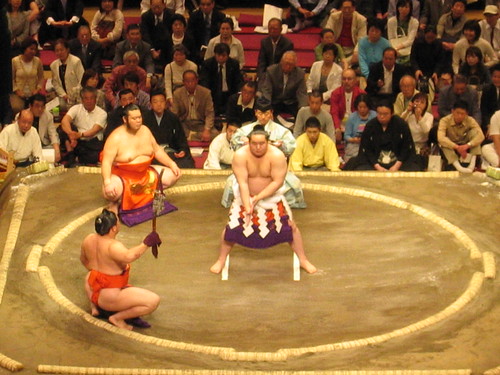Mongolia’s presidential election is taking place today, and former Prime Minister, Nambariin Enkhbayar, looks slated to win. His party – the Mongolian People’s Revolutionary Party – is the former communist party, and his popularity reflects a communist-era nostalgia that’s been a force in Mongolian politics since shortly after the fall of the Soviet Union. On the other hand, the Mongolian president is less powerful than the Prime Minister – Tsakhiagiin Elbegdorj – who represents the relatively liberal democrats.
There’s no reason to expect any fireworks around the Mongolian election – as we saw with the Kyrgyz parliamentary elections – as there have been multiple free elections in the country, and power has changed hands, unlike in Kyrgyzstan and Uzbekistan, where powerful leaders (had) ruled for long periods of time. And, indeed the election isn’t getting much coverage.
But the last line of the story Reuters ran on the Mongolian election caught my eye. It reads:
“Genghis Khan, born around 1167, unified disparate Mongolian tribes to create a lethal, fighting force that rode roughshod over China and Central Asia and forged a short-lived empire that reached as far west as Poland and Hungary.”
So let me get this straight: a critical piece of context for an article on contemporary Mongolian politics is the nation’s 800 year old military history? It’s like finishing a story about Tony Blair’s recent parliamentary victory with a paragraph about the Norman conquest.
(Okay, to be fair – maybe the Mongolians bring the Khan connection on themselves. When I was last in Ulaanbaatar, I stayed in the Chinggis Khan hotel, drank Chinggis vodka and generally got all the Khan I could handle.)
Let me offer a bit of contemporary Mongolian trivia to balance Reuters’ useful bit of historical trivia: Mongolians have become the dominant force in Japanese sumo wrestling.
When I was in Japan two weeks ago, I was lucky enough to catch the second day of the May sumo tournament (basho). The highlight of the afternoon was watching Yokozuna (top-ranked wrestler) Asashoryu demolish his opponent, grabbing him by the belt and flipping him over his hip a few seconds after the match began. Today, Asashoryu won his fifteenth match of the basho, and now ties an interesting sumo record – he’s won 12 Emperor’s Cups (the prize for winning a basho), tying him with Musashimaru for the most Cups won by a non-Japanese wrestler.
A Mongolian, originally named Dolgorsuren Dagvadorj, Asashoryu is one of the most dominant wrestlers sumo has seen in recent years. And he’s not alone. Early last year, WebJapan reported that 53 of the 693 professional sumo wrestlers in Japan were foreign-born, and 35 of the 53 were from Mongolia. At the most senior Maku-uchi ranks, the Mongolian presence is even more obvious: Russia, Georgia and Bulgaria each have produced a sumo wrestler currently competing at the sport’s top level – by contrast, there are seven Mongolians in the sport’s most challenging division.
The last wave of foreign wrestlers who shook up sumo were Pacific Islanders – mainly Hawaiians – who were notable in part due to their sheer size. Konishiki – now a popular entertainer in Japan – was almost 600 pounds when he fought; Akebono and Musashimaru weren’t much lighter.
The Mongolians look tiny in comparison. Asashoryu isn’t exactly skinny, but at 145kg (319 pounds), he’s a petite guy who wins with skill and technique, not sheer power. Ama, one of my favorite Mongolian wrestlers weighs in at only 115kg (253 pounds)… slightly lighter than I am. They’re tons of fun to watch as they pivot, throw and slap much larger men down to the dirt floor of the dohyo.
Why are the Mongolians so good at this eminently Japanese sport? Well, turns out it’s a Mongolian sport as well. Visit a Mongolian picnic and you’ll see young men grabbing each other in informal wrestling matches, the same way Americans would throw a frisbee around or Indians would set up a wicket and play pickup cricket.
Bayirldax, traditional Mongolian wrestling, has rules very similar to sumo, and is extremely popular, both as part of the annual Naadam festival, and throughout the year. Asashoryu is part of a proud and successful Mongolian wrestling family – his success in Japan is both a source of pride in Mongolia, and seen as a natural outgrowth of his family’s wrestling prowess.
So good luck with the elections, Mongolia, land of Yokozuna Asashoryu.

It occurs to me, apropos of nothing, that one can chant “A-sa-sho-ryu” to the same rhythm as “O-zo-mat-li!”
I’d love to see him heralded into the room with a contingent of funk-Latin-hiphop percussionists… :-)
Ethan, I had to let you know that I went to the last day of the bashyo…:-)
Matt
And now I’m envious, Matt. That would have been great to see. Glad you were able to make it.
Pingback: …My heart’s in Accra » Blogging makes it big
Comments are closed.